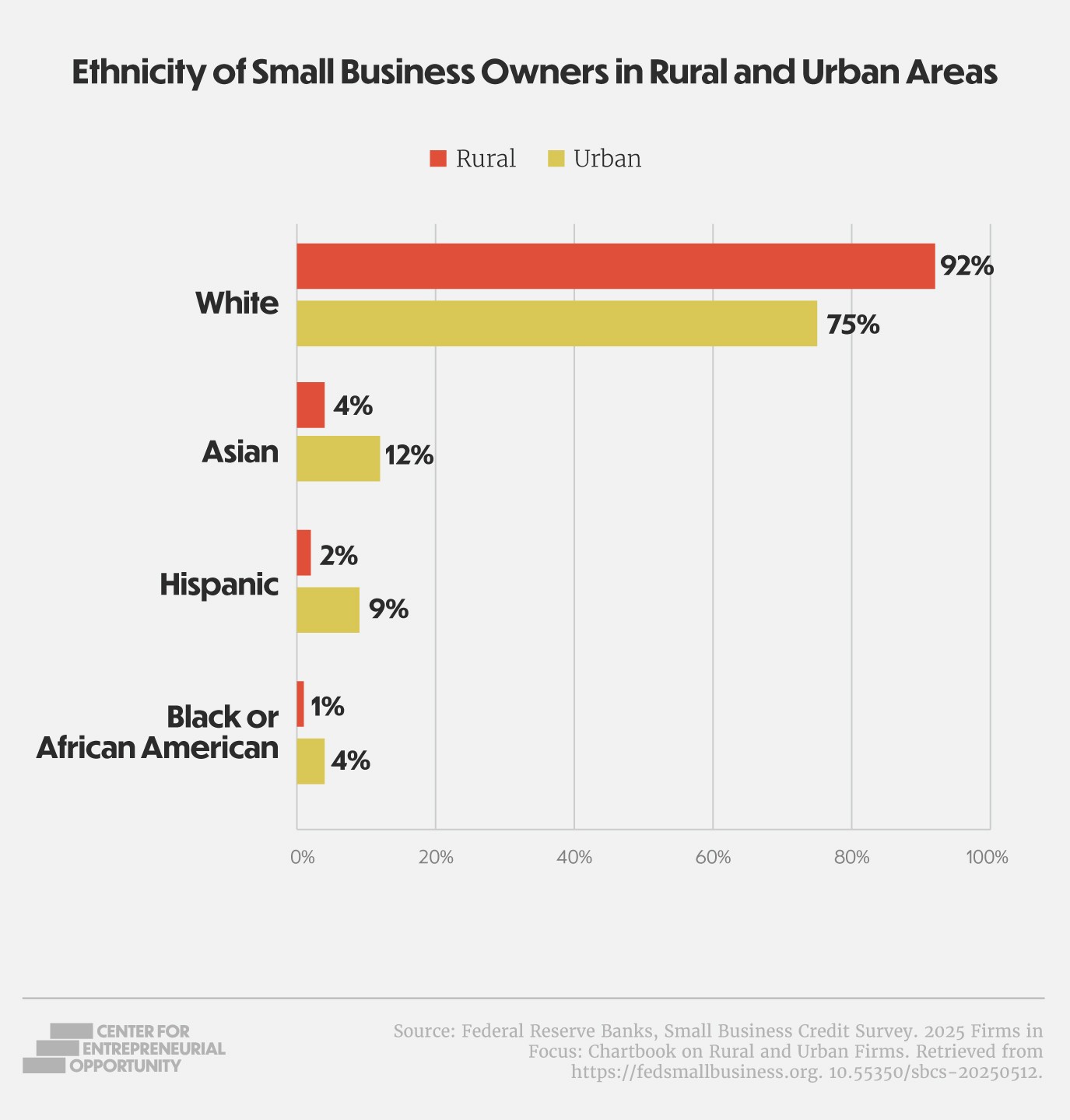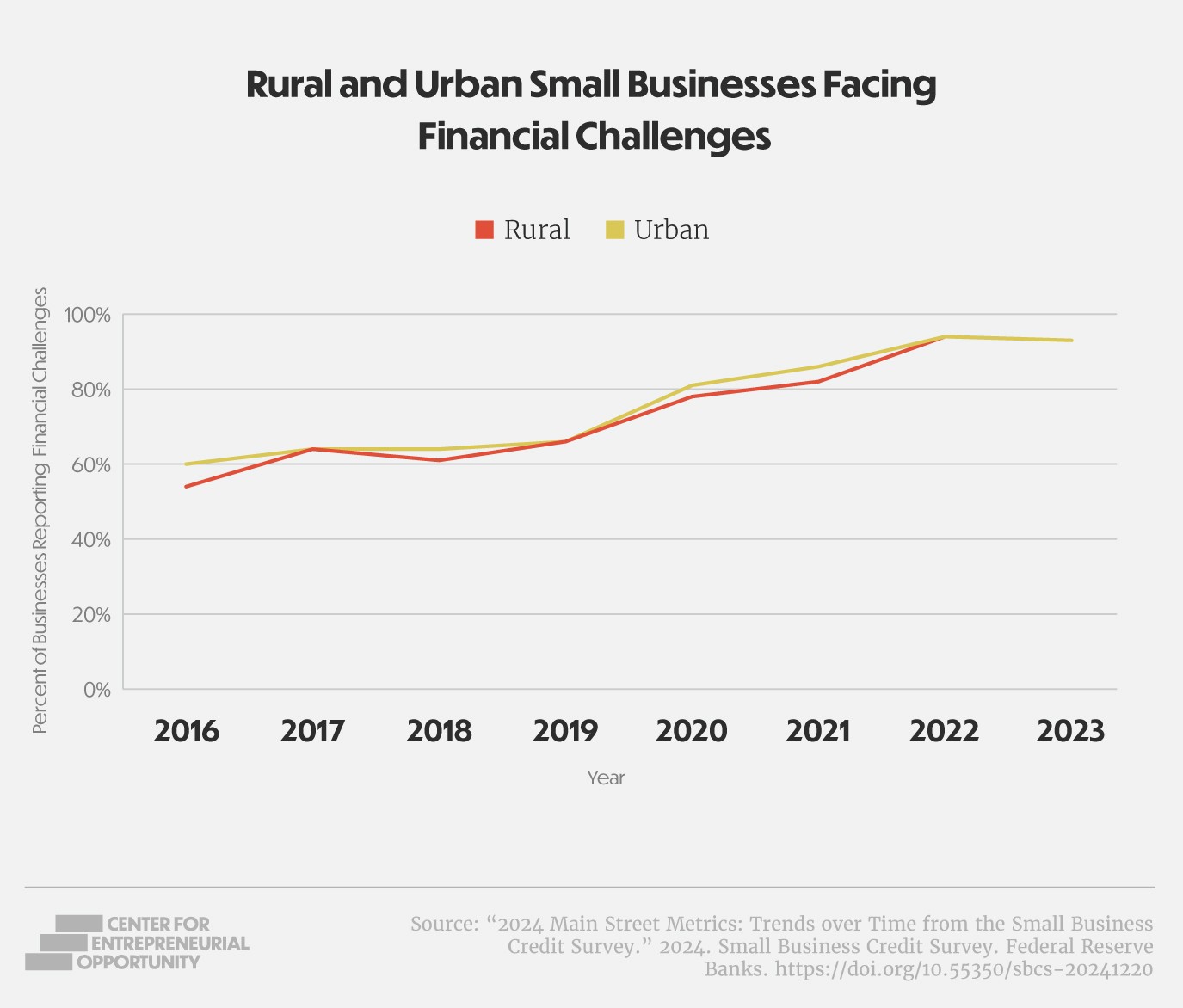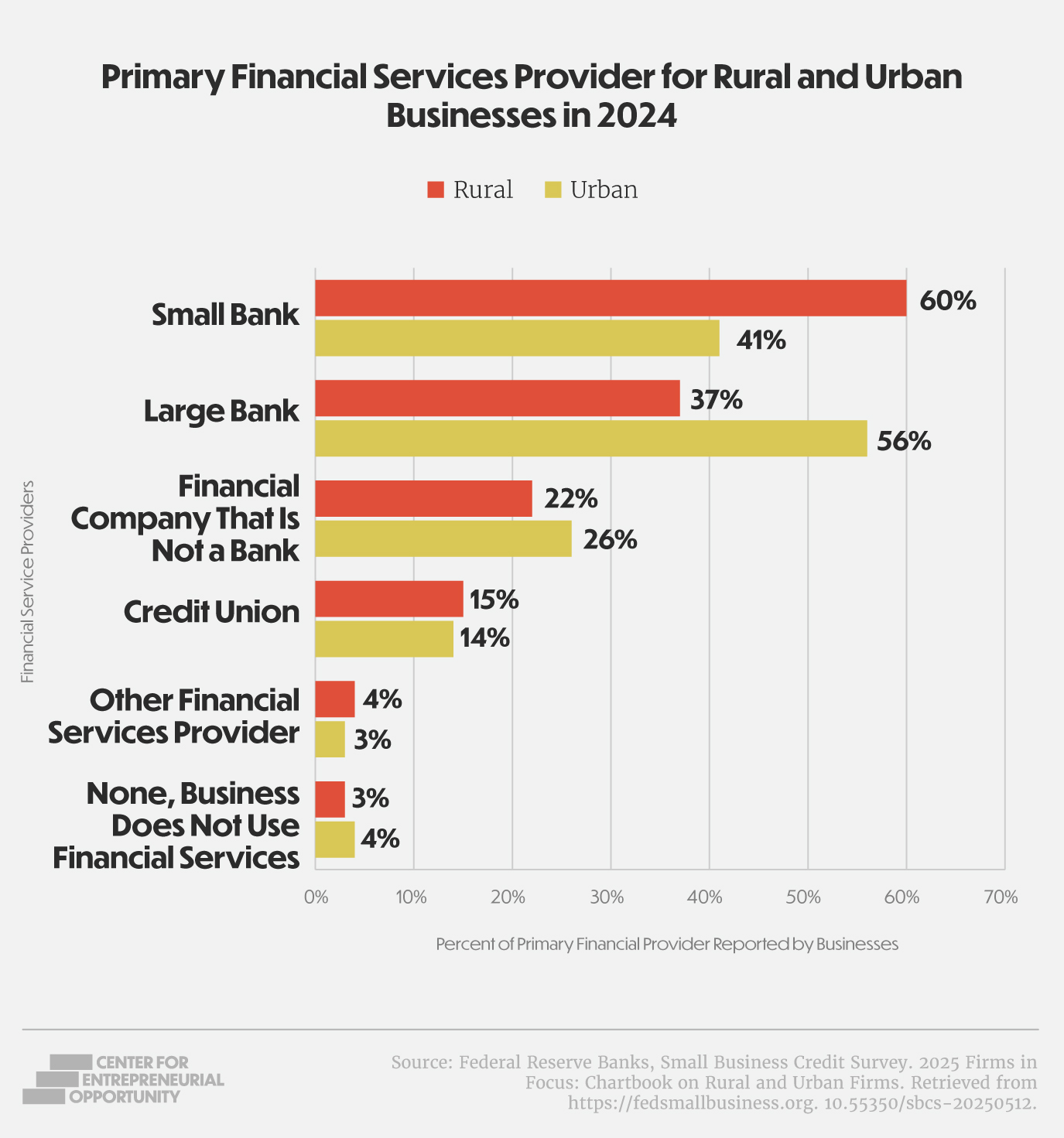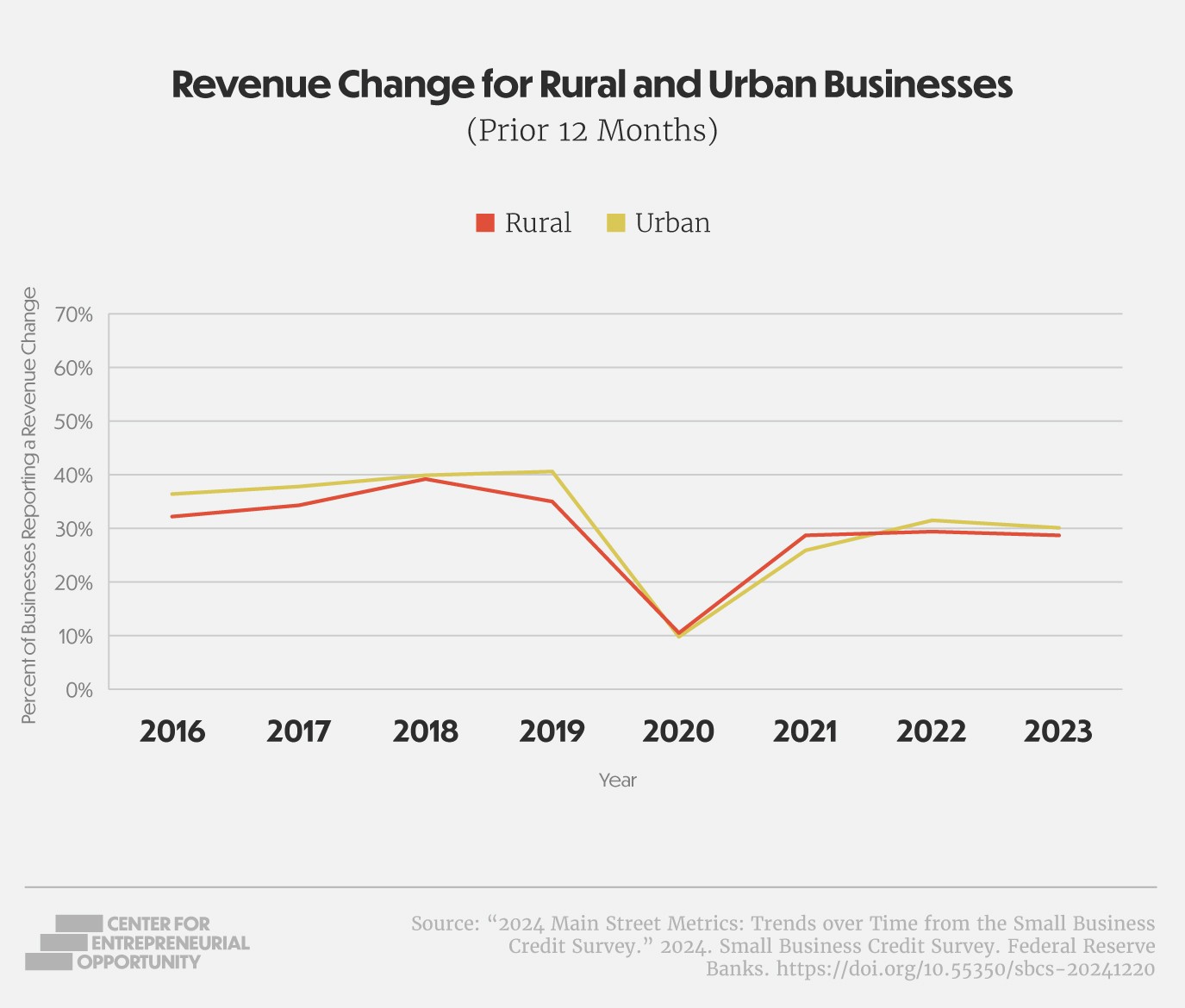8 Findings: Small Businesses in Rural America

Takeaways
Data shows that rural small businesses have enduring strengths but face evolving pressures. Ownership remains largely non-diverse, with women and minority entrepreneurs still underrepresented. Many rural firms operate in hands-on industries like construction, farming, and wholesale trade—sectors that continue to anchor rural economies. At the same time, hiring and retaining workers has become a growing concern. Financial strain is widespread, driven by rising costs. Reliance on small banks for funding remains strong—even as that relationship shows signs of shifting. The lasting impact of the COVID-19 pandemic is still felt, with uneven revenue recovery and cautious growth expectations. While many rural businesses have solid credit, securing loans remains a challenge.
Small businesses make up 85% of all businesses in rural America, anchoring local economies.1 They provide essential jobs and services, yet face unique challenges—including limited diversity, hiring struggles, and significant financial pressures. Drawing on nine years of data from the Federal Reserve's Small Business Credit Survey, this report offers a clear view of the rural business landscape today—its patterns, pain points, and potential.
Specifically, we find:
- Diverse ownership still lags in rural America.
- Rural businesses struggle to hire and keep workers.
- Financial struggles mount for rural business owners.
- Non-manufacturing goods drive rural business growth.
- Rural firms rely on small banks for financing.
- The COVID-19 pandemic hit rural businesses especially hard.
- Rural firms remain small with limited job-growth expectations.
- Rural businesses have good credit but struggle to secure loans.
Diverse ownership still lags in rural America.
Rural businesses continue to be mostly white owned, a trend that has remained consistent.2 The most recent data from 2024 shows that white business ownership at 92% in rural areas, compared to Black ownership at 1% and Hispanic and Asian ownership lingering at 2% and 4% respectively.3
Women also remain underrepresented as business owners. In 2024, 22% of rural businesses were women-owned and over 50% of rural businesses being owned by men.4 This low figure has remained relatively unchanged with 22% of women-owned businesses located in rural areas in 2021.5 The overall trend shows persistent gender disparity in rural business ownership.

Rural businesses struggle to hire and keep workers.
Rural businesses increasingly struggle with workforce challenges. For the last two years, hiring and retaining staff was their top concern, superseding supply chain issues.6 This staffing challenge affects both rural and urban enterprises, though more severely in rural areas, where more than half of businesses report workforce difficulties compared to just 50% of firms in urban settings.7
Financial struggles mount for rural business owners.
From 2016 to 2023, there was a significant increase in the number of rural businesses reporting financial challenges.8 While just over half of rural small business owners experienced economic hardship in 2016, this figure surged to 93% by 2023—a 37-percentage point increase. The trend continued upward, reaching its peak in 2024 when 94% of all rural small businesses faced financial constraints, highlighting sustained and pervasive economic challenge across rural America.9
In 2024, the primary financial concern for rural businesses shifted from paying operating expenses to rising costs, with increased expenses for goods, services, and wages taking center stage. In 2024, this became the biggest financial challenge for both rural and urban businesses, with 76% of rural businesses and 75% of urban businesses reporting this issue.10

Non-manufacturing goods drive rural business growth.
Rural businesses have consistently maintained a stronghold in the non-manufacturing goods production sector.11 In 2024, 20% of rural businesses operated in industries like construction, farming, warehousing, mining, and wholesale trade.12 This steady concentration underscores the foundational importance that hands-on enterprises continue to play in rural economies, often shaping supply chains across the country.
Rural firms rely on small banks for financing.
From 2021 to 2024, rural small businesses consistently lean on small banks for their financial needs—a marked difference to urban businesses, which are more likely to turn to large banks.13 In 2024, 60% of all rural small businesses worked with a small bank, compared to just 41% of urban businesses.14 Small banks remain a cornerstone of rural small business financing.

The COVID-19 pandemic hit rural businesses especially hard.
Following the COVID-19 pandemic, rural small businesses struggled to maintain a profit in 2021 with only 38% of rural small businesses experiencing a profit, compared to 62% the previous year.15 By 2024, just 37% experiencing an increase in revenue, underscoring the uneven recovery across rural economies.16
Predictably, small business optimism plummeted during 2020, with only 40% of owners expecting revenue growth—down sharply from 69% the year prior. Though confidence slowly rebounded since then, recovery remains stagnant.17

Rural firms remain small with limited job-growth expectations.
Since 2016, rural firms have consistently remained small-scale operations with the majority employing just one to four workers.18 This trend persisted in 2024, with 61% of rural businesses maintaining minimal staffing.19 Growth prospects remain limited, as only 33% of rural small businesses plan to expand their workforce.20 This cautious approach to hiring reflects a modest shift from pandemic levels, indicating persistent economic uncertainty.
Rural businesses have good credit but struggle to secure loans.
Federal resources, such as loans from the Small Business Administration (SBA), can be a lifeline for businesses. But many in rural areas may struggle to secure the financing they need. In 2024, 40% of rural small businesses either received partial or no funding they applied for.21 At the same time, many rural businesses have maintained strong credit profiles: more than 66% of rural businesses were a low credit risk in 2024.22 Despite their creditworthiness, loan approval rates remain low, highlighting a disconnect that raises concerns about equitable access to capital in rural communities.
However, only less than a quarter of rural small businesses applied for an SBA loan, choosing instead to most often apply for a line of credit.23 This could suggest that SBA might be a good alternative for financing among rural businesses.
Meanwhile, debt levels have remained elevated. Before the pandemic, only about a quarter of rural small businesses carried debt, but this spiked to 79% in 2020. Although it dipped in subsequent years, 76% still carried debt in 2024, with 37% identifying debt repayment – including interest – as their most significant financial challenge.24
Endnotes
Wilmoth, Daniel. Small Businesses in Rural Areas. Small Business Facts, U.S. Small Business Administration, Office of Advocacy, Aug. 2023, https://advocacy.sba.gov/wp-content/uploads/2023/08/Fact-Sheet-Small-Business-in-Rural-Areas-508c.pdf. Accessed June 24, 2025.
Federal Reserve Banks, Small Business Credit Survey. 2025 Firms in Focus: Chartbook on Firms by Race and Ethnicity of Ownership. 31 May 2024, https://www.fedsmallbusiness.org/reports/survey/2025/2025-small-business-data-chartbooks. Accessed June 24, 2025.
Federal Reserve Banks, Small Business Credit Survey. 2025 Firms in Focus: Chartbook on Firms by Race and Ethnicity of Ownership. 31 May 2024, https://www.fedsmallbusiness.org/reports/survey/2025/2025-small-business-data-chartbooks. Accessed June 24, 2025.
Federal Reserve Banks, Small Business Credit Survey. 2025 Firms in Focus: Chartbook on Firms by Gender of Ownership. 31 May 2024, https://fedsmallbusiness.org. Accessed June 24, 2025.
Federal Reserve Banks, Small Business Credit Survey: 2021 Small Business Credit Survey, Federal Reserve Banks Retrieved from https://www.fedsmallbusiness.org/ (Page 48). Accessed June 24, 2025.
Federal Reserve Banks, Small Business Credit Survey. 2025 Firms in Focus: Chartbook on Firms by Race and Ethnicity of Ownership. 31 May 2024, https://www.fedsmallbusiness.org/reports/survey/2025/2025-small-business-data-chartbooks. Accessed June 24, 2025.
Federal Reserve Banks, Small Business Credit Survey. 2025 Firms in Focus: Chartbook on Firms by Race and Ethnicity of Ownership. 31 May 2024, https://www.fedsmallbusiness.org/reports/survey/2025/2025-small-business-data-chartbooks. Accessed June 24, 2025.
Federal Reserve Banks, 2025 Main Street Metrics: Trends over Time from the Small Business Credit Survey.” 24 April 2024, https://www.fedsmallbusiness.org/reports/survey/2025/2025-main-street-metrics. Accessed June 24, 2025.
Federal Reserve Banks, 2025 Main Street Metrics: Trends over Time from the Small Business Credit Survey.” 24 April 2024, https://www.fedsmallbusiness.org/reports/survey/2025/2025-main-street-metrics. Accessed June 24, 2025.
Federal Reserve Banks, Small Business Credit Survey. 2025 Firms in Focus: Chartbook on Firms by Race and Ethnicity of Ownership. 31 May 2024, https://www.fedsmallbusiness.org/reports/survey/2025/2025-small-business-data-chartbooks. Accessed June 24, 2025.
Federal Reserve Banks, Small Business Credit Survey. 2025 Firms in Focus: Chartbook on Firms by Race and Ethnicity of Ownership. 31 May 2024, https://www.fedsmallbusiness.org/reports/survey/2025/2025-small-business-data-chartbooks. Accessed June 24, 2025.
Federal Reserve Banks, Small Business Credit Survey. 2025 Firms in Focus: Chartbook on Firms by Race and Ethnicity of Ownership. 31 May 2024, https://www.fedsmallbusiness.org/reports/survey/2025/2025-small-business-data-chartbooks. Accessed June 24, 2025.
Federal Reserve Banks, Small Business Credit Survey. 2025 Firms in Focus: Chartbook on Firms by Race and Ethnicity of Ownership. 31 May 2024, https://www.fedsmallbusiness.org/reports/survey/2025/2025-small-business-data-chartbooks. Accessed June 24, 2025.
Federal Reserve Banks, Small Business Credit Survey. 2025 Firms in Focus: Chartbook on Firms by Race and Ethnicity of Ownership. 31 May 2024, https://www.fedsmallbusiness.org/reports/survey/2025/2025-small-business-data-chartbooks. Accessed June 24, 2025.
Federal Reserve Banks, Small Business Credit Survey. 2024 Main Street Metrics%u200B: Trends over Time. 20 December 2024. https://www.fedsmallbusiness.org/reports/survey/2024/2024-main-street-metrics. Accessed June 24, 2025.
Federal Reserve Banks, Small Business Credit Survey. 2024 Main Street Metrics%u200B: Trends over Time. 20 December 2024. https://www.fedsmallbusiness.org/reports/survey/2024/2024-main-street-metrics. Accessed June 24, 2025.
Federal Reserve Banks, Small Business Credit Survey. 2024 Main Street Metrics%u200B: Trends over Time. 20 December 2024. https://www.fedsmallbusiness.org/reports/survey/2024/2024-main-street-metrics. Accessed June 24, 2025.
Federal Reserve Banks, Small Business Credit Survey. 2016 Report on Rural Employer Firms. 22 December 2017, https://www.fedsmallbusiness.org/reports/survey/2017/report-on-rural-employer-firms. Accessed June 24, 2025.
Federal Reserve Banks, Small Business Credit Survey. 2025 Firms in Focus: Chartbook on Firms by Race and Ethnicity of Ownership. 31 May 2024, https://www.fedsmallbusiness.org/reports/survey/2025/2025-small-business-data-chartbooks. Accessed June 24, 2025.
Federal Reserve Banks, Small Business Credit Survey. 2025 Firms in Focus: Chartbook on Firms by Race and Ethnicity of Ownership. 31 May 2024, , https://www.fedsmallbusiness.org/reports/survey/2025/2025-small-business-data-chartbooks. Accessed June 24, 2025.
Federal Reserve Banks, Small Business Credit Survey. 2025 Firms in Focus: Chartbook on Firms by Race and Ethnicity of Ownership. 31 May 2024, https://www.fedsmallbusiness.org/reports/survey/2025/2025-small-business-data-chartbooks. Accessed June 24, 2025.
Federal Reserve Banks, Small Business Credit Survey. 2025 Firms in Focus: Chartbook on Firms by Credit Risk. 12 May 2025, https://www.fedsmallbusiness.org/reports/survey/2025/2025-small-business-data-chartbooks. Accessed June 24, 2025.
Federal Reserve Banks, Small Business Credit Survey. 2025 Firms in Focus: Chartbook on Firms by Race and Ethnicity of Ownership. 31 May 2024, https://www.fedsmallbusiness.org/reports/survey/2025/2025-small-business-data-chartbooks. Accessed June 24, 2025.
Federal Reserve Banks, Small Business Credit Survey. 2025 Main Street Metrics: Trends over Time from the Small Business Credit Survey. 24 April 2024, https://www.fedsmallbusiness.org/reports/survey/2025/2025-main-street-metrics. Federal Reserve Banks. Accessed June 24, 2025.
